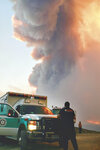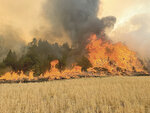, 76° F
Knowing the mountain range where he grew up hunting, fishing and camping with his family will never be the same in his lifetime, 2015 Powell High graduate and former Powell Valley Healthcare …
This item is available in full to subscribers.
The Powell Tribune has expanded its online content. To continue reading, you will need to either log in to your subscriber account, or purchase a subscription.
If you are a current print subscriber, you can set up a free web account by clicking here.
If you already have a web account, but need to reset it, you can do so by clicking here.
If you would like to purchase a subscription click here.
Please log in to continue |
|





Knowing the mountain range where he grew up hunting, fishing and camping with his family will never be the same in his lifetime, 2015 Powell High graduate and former Powell Valley Healthcare emergency medical technician and paramedic Ben Wetzel has taken being on the front lines at the Elk Fire personally.
“I’ve been out here seven or eight days now. We all feel very close because it’s our mountain. We spend all of our time out here on our days off, and so it feels personal that we need to be out here and part of the team trying to do something,” he said while working the line in Division Zulu.
The blaze, which officials have attributed to a lightning strike, began Sept. 27. As of Monday the fire has grown to about 90,000 acres and has drawn 944 firefighters and support staff to the incident. After the hurricane ravaged southeast, the Elk Fire is currently listed as the second highest priority incident for the federal government.
Currently the fire is 27% contained, according to Rocky Mountain Area Complex Incident Management’s Team 3 update Monday morning, up about 13% since late last week. While the fire continues to grow, meetings were held in communities at risk, including Dayton and Story, over the weekend. Damage to homes, structures, livestock, wildlife and habitat have been devastating as a combination of unusually high heat for the season, dry conditions and, at times, high winds have pushed the fires.
Sunday there were moderate temperatures, slightly lower relative humidity, and lingering smoke, according to official reports. This resulted in minimal fire activity during the day. However, later that evening lower humidity resulted in more fire activity than recent nights. Monday was warmer and drier with a westerly wind moving to a northwesterly wind. This was expected to increase fire activity on the southern end of the fire near Story.
Top training
Division Zulu is on the northern edge of the fire. Wetzel’s presence is important as the only working certified wilderness paramedic in the state (one of only 144 in the world). He is also qualified as a firefighter; a rare combination which allows him to fight on front lines of fires, but also to give medical support to those fighting in high risk conditions.
After high school, Wetzel earned an associate degree in paramedic sciences through Casper College and a bachelor’s degree from the University of Wyoming in human physiology. In Powell he quickly moved up the ranks from an emergency medical technician working on an ambulance in the area to a crew chief. He then moved to Sheridan for an opportunity at Wyoming Regional Emergency Medical Services as a lead shift medic.
The Elk Fire isn’t the only fire Wetzel has helped fight this year. He has worked the Remington, Constitution and Flat Rock fires, to name a few across the northeast region this summer. The Elk Fire, which is the largest recorded fire in Bighorn National Forest, is personal for many first responders.
“When the Elk Fire popped off, those of us that are primarily stationed in Sheridan felt a lot more drive to be out here,” Wetzel said.
He said he’s always had the stomach and urgency for responding to tragic scenes, something he said is a common trait for those who answer the call to serve as a first responder. But in the end, he was searching for something that matched his abilities along with a chance to serve his community.
“I’ve grown up around a family that gives back to the community, and I’ve always been a bit of an adrenaline junkie, but wanted to find my way to have an impact and to give back,” Wetzel said.
There are tough days watching fires overtake residences and pushing wildlife from their habitats, he said. Wetzel, who is the son of Powell Mayor John Wetzel and Executive Director of the NWC Foundation Shelby Wetzel (also a co-owner of the Powell Tribune), was on the line in the past week and saw a young bear wandering aimlessly through the burned landscape. It saddened him after seeing photographs posted of other wildlife that was caught in the fast moving fire.
“You could see this black bear looked lost and confused. It was a younger bear and it had probably never seen fire in its life. It has nowhere to go. All of the territory it lived in all its life has just been destroyed,” he said.
Every fire Wetzel has responded to has been different for livestock and wildlife, some much worse than others. However, the Wyoming Game and Fish Department has actively been on scene at the Elk Fire and reported in preliminary observations Monday most wildlife is adept at moving away from fire, according to Christina Schmidt, Sheridan Region public information specialist.
“We have approximately 90 mule deer in the northern Bighorn Mountains fitted with GPS collars that are being monitored as part of the statewide mule deer focal herd monitoring project. The movement data shows most of those animals were outside the current fire perimeter prior to the fire and remain so currently. A few animals are within the fire perimeter, but no mortalities have been noted from this data and no collars have gone offline,” she said.
The Amsden Creek and Kerns wildlife habitat management areas have been heavily impacted. Amsden Creek WHMA has been impacted greater than Kerns WHA at this time, but both of those commission-owned properties were originally purchased for and have been managed for decades as winter range for big game animals.
“We expect animals that traditionally use these properties may move to new areas this winter,” Schmidt said.
Wildlife managers will work with landowners and land management agencies to monitor these movements in coming months. If the public sees an injured animal, whether potentially due to the fire or to other causes, they can call the Stop Poaching Hotline at 1-877-WGFD-TIP. It operates 24 hours a day and the report is sent to the nearest game warden or wildlife biologist to respond.
New education opportunities
There is a huge need for first responders across the nation, according to instructor Steven Haggard, and Northwest College has responded with an updated program for EMS and paramedic program students.
Northwest College has made changes to the offered Associate of Applied Science degree in emergency medical services/paramedicine program. The changes were introduced after Haggard took over the program as Fixed Term Instructor of Emergency Medical Services.
He started his career at a young age after joining the volunteer fire department in his hometown in central Tennessee.
“The very first incident I worked, I was a volunteer fireman. I was 15, and we had a structure fire with [a fatality], he said. “I had been 15 years old for six days, and helped carry the body out of the house. I knew then that, ‘hey, this is something I can do. I’ve been blessed with a talent. I need to use it.’”
The school made changes to the program to make it more student centered, Haggard said. Previously the class schedule was more typical of other programs. But they faced an issue of students failing to retain information after summer break.
“We were teaching things that we shouldn’t have had to reteach,” he said.
Announced in July, the college has adopted a coursework schedule beginning the four-semester Paramedic Skills Certificate with a single course in the summer, followed by one course during the fall and one during the ensuing spring semesters. The program is completed with one more course the following summer, preparing students to sit for the National Registry Examination and achieve NREMT certification.
Classes must be passed with a B-minus or higher to progress. It’s a longer haul, but the students will graduate in about 15 months ready to work. The primary goal of the program is to provide the working advanced emergency medical technicians with career mobility and an avenue to provide safe, competent care as an entry-level paramedic.
“Anything that I can use my program for, to help address needs in the community — what the community needs long term as far as health care and what we can do to address shortages in employment — I want to be a part of making the community safer and healthier,” he said.
For students who have already earned a college degree and meet NWC’s prerequisites, the Paramedic Skills Certificate allows them to pursue further education without needing to enroll in another degree-seeking program.
Marnee Crawford, director of nursing, said in December the decision to offer a shorter paramedic program was in response to many conversations with students and health care partners, as well as a “dire shortage” of EMS professionals across the state and nation. The college already offers an associate’s degree for advanced EMTs to rise to the next level, but many students already in the field don’t want to take — or have — the extra time.
Students have said paramedics don’t need to have the degree, but they do need the training, Crawford said.
“We examined where potential students are going, [and] talked to clinical partners. Some said they didn’t come here because it took too long to get through the program,” said NWC President Lisa Watson. “This is a nice way of meeting some community needs,” she said in her January address.
Unadvertised employment benefits
Despite his high level of knowledge and qualifications, Wetzel said classwork and training is a constant for EMS and paramedic employees. Whether it is continuing college classwork or studying the newest techniques and technology for recertification efforts, the learning opportunities never end.
Wetzel has thousands of hours of training and testing since choosing his career; something he takes extremely serious. At the same time he loves what he does.
“Once you get into it, it’s hard to walk away,” he said.
There are benefits to the job that few may consider when researching a career as a first responder. First responders share an unusual sister and brotherhood due to the common denominators of putting your life on the line for a job, working odd and long hours and dealing with emotional stress from subjecting yourself to seeing life hanging by a thread — or worse. Wetzel said he has met many likeminded friends while on the job he hopes will last a lifetime.
“It’s a very, very small world amongst first responders, especially in Wyoming,” he said. “Without a shadow of doubt, 90% of my best friends in the world are all either firefighters or paramedics that I’ve worked with at one point or another.”